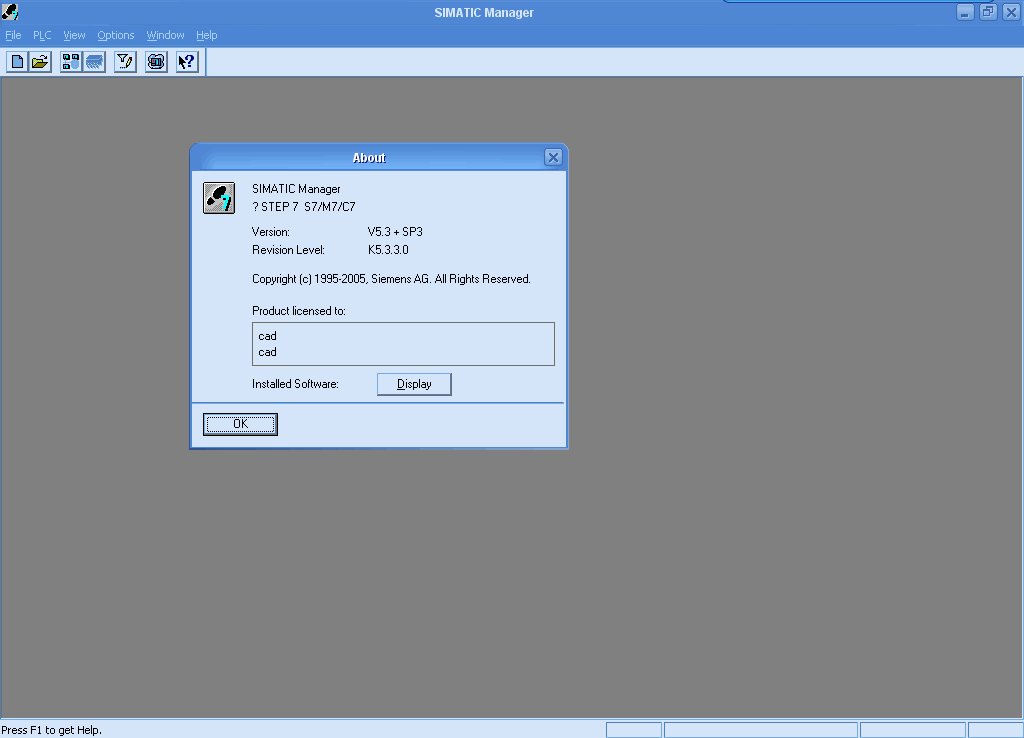Simatic Step 7 V5 3 Crack
ScreenShots: Software Description: Siemens SIMATIC STEP 7 software is theprofessional tool for the SIMATIC S7, SIMATIC C7 and SIMATIC WinACautomation systems. It enables the user to use the performancecapability of these systems easily and conveniently. SIMATIC STEP 7 contains convenient functions for all phases of anautomation project: – Configuring and parameterizing the hardware – Specifying the communication – Programming – Test, start-up and service – Documentation, archiving – Operating/diagnostics functions SIMATIC STEP 7 program tools: 1. SIMATIC-Manager: The SIMATIC Manager manages all data belonging to an automationproject, regardless of the target system (SIMATIC S7, SIMATIC C7 orSIMATIC WinAC) on which they are implemented. It provides a common entry point for all SIMATIC S7, C7 or WinACtools. The SIMATIC software tools that are necessary for processingthe selected data are automatically started by SIMATIC Manager.
The precondition for installation of the upgrade package is a valid license for STEP 7 V5.3, V5.4, or V5.5. STEP 7 V5.6 Rental License: Users who only work with STEP 7 occasionally, can purchase a Rental License with an operating time of 50 hours. The time starts elapsing when STEP 7 is started and stops when STEP 7 is closed. Mar 20, 2013 - i.e. To be able to install Service Pack 3, STEP7 V5.5 or STEP 7. The SP3 for STEP 7 V5.5 is part of this DVD (see entry ID 67878325 ).
Symbol-Editor: With the tool Symbol Editor all global variables (in contrast tothe local formal parameters that are declared when the blocks areprogrammed) are managed. The following functions are available: – Definition of symbolic designations and comments for the processsignals (inputs/outputs), flags and blocks – Sorting functions – Data exchange with other Windows programs The symbol charts that are generated when this tool is used areavailable to all software products. Changes to a symbol parameterare therefore automatically recognized by all tools. Hardware configuration: The tool Hardware Configuration is used for configuring andparameterizing the hardware used for an automation project. Thefollowing functions are available: – Configuration of the automation system Racks are selectedfrom an electronic catalog and the selected modules are assigned tothe required slots in the racks. – The configuration of the distributed I/Os is done in the same wayas the configuration of the non-distributed I/Os; channel-granularI/O modules are also supported.
– CPU parameter assignment: Properties such as restart characteristics and cycle-timemonitoring can be set menu-driven. Multicomputing is supported. Prikaz myu rf ot 03112005 g 204 dsp. Theentered data are filed in system data blocks in the CPU. – Module parameter assignment: The user can specify all the adjustable parameters of the modulesin input screen forms. Adjustments via DIP switches becomeunnecessary. Parameterization of hardware modules occursautomatically during the CPU’s acceleration.


Thus, a change of amodule can be made without another parameterization. – Function module (FM) and communications processor (CP) parameterassignment: This parameterization also occurs within the hardware configurationin the same way as the parameterization of the other modules. Forthis parameterization hardware-module-specific screen forms andrules are provided for each FM and CP (is included in the FM/CPfunctions package). The system prevents faulty inputs by offeringonly allowed entry options on the parameter assignment screenforms. Vasilj bika nezagojnaya rana sachinenne.
Communication configuration: – Configuring and display of communication links – Time-driven cyclic data transmission via MPI: – Selection of communication partners – Entering of data source and data destinationin a table.Generation of all system data blocks (SDBs) to be loaded and theircomplete transmission to all CPUs take place automatically – Parameterization of the selected communicationblocks in the customary programming language (e.g., LAD). Event-driven data transmission – Definition of the communication links.
– Selection of the communication function blocks (CFBs) from theintegrated block library. – Parameterization of the selected communication blocks in thecustomary programming language (e.g., LAD). System diagnostics: System diagnostics offer the user an overview of the status of theautomation system.